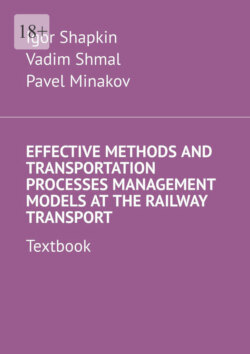Effective Methods and Transportation Processes Management Models at the Railway Transport. Textbook

Реклама. ООО «ЛитРес», ИНН: 7719571260.
Оглавление
Vadim Shmal. Effective Methods and Transportation Processes Management Models at the Railway Transport. Textbook
INTRODUCTION
1 INFORMATIZATION AS A STRATEGIC COURSE FOR THE RAILWAY TRANSPORT RESTRUCTURING
2 TRAFFIC MANAGEMENT MODERN MODELS
2.1 Subject and tasks of decision-making in railway transport
2.2 Mathematical modeling of operations
2.3 Different types of operations research problems and methods for solving them
2.4 Multi-criteria Operations Research Tasks
2.5 Dynamic programming method
2.6 Data processing statistical models
3 TRAFFIC FLOW MANAGEMENT MODERN MODELS
3.1 Car fleet management model in multiple operators conditions
4 OPTIMIZATION MODELS AND DECISION-MAKING METHODS FOR RAIL TRANSPORT MANAGEMENT
4.1 Optimization basic principles
4.2 Markov chains in the dynamics of objectively developing events in the human-machine system, which is still the transportation process
4.3 Algorithm for optimizing a passenger technical station using probabilistic models as a complex system
4.4 Selection of the effective and legitimate expert assessments scope in the considered discrete-continuous movements of the train and commodity flows in time and space
5 MODERN METHODS AND MODELS OF MULTIFACTOR RATIONING AND FORECASTING IN RAILWAY TRANSPORT
6 TRANSPORT PROCESSES SIMULATION
6.1 Train operation simulation at stations and sections of railways
6.2 The essence of simulation modeling. Simulation modeling in management
7 MODERN MANAGEMENT MODELS IN THE TRANSITION TO POLYGON TECHNOLOGIES
8 INTELLIGENT TRANSPORT SYSTEMS (ITS)
8.1The main ITS development directions
8.2 Operational management intellectualization principles of the transportation process in railway transport
8.3 Digital technologies are the basis for railway operations efficiency increasing
9 COST-EFFECTIVENESS OF DECISION-MAKING METHODS AND MODELS IN RAILWAY TRANSPORT
9.1 Logistic model of the transportation process corporate quality management
9.2 Methods and tools for making effective transportation management decisions on the railway network
9.3 Creation of terminal complexes functioning economic and mathematical models
Literature
Отрывок из книги
In the country’s transport system, rail transport occupies a leading place in the development of the Russian economy. The most important role in the strategy for the development of railway transport in Russia belongs to the process of informatization, which provides the necessary and reliable information to all areas of management related to the transportation of goods and passengers. For fundamental scientific, technical and organizational problems solvation, the Concept and Program of Informatization of Railway Transport have been developed.
In the context of large-scale reforms in railway transport informatization is carried out using information technologies, the most important elements of which are models, methods and algorithms for making control decisions.
.....
Before us is a typically mathematical problem belonging to the class of so-called variational problems. Methods for solving such problems are analyzed in detail in mathematics. The simplest of these methods (the well-known «maximum and minimum problems») are familiar to every engineer. These methods prescribe to find the maximum or minimum (in short, the «extremum») of the function to differentiate it by arguments, equate the derivatives to zero and solve the resulting system of equations. However, this classical method has only limited application in the study of operations. First, in the case when there are many arguments, the task of solving a system of equations is often not easier, but more difficult than the direct search for an extremum. Secondly, the extremum is often reached not at all at the point where the derivatives turn to zero (such a point may not exist at all), but somewhere at the boundary of the area of change of arguments. All the specific difficulties of the so-called «multidimensional variational problem in the presence of limitations» arise, sometimes unbearable in its complexity even for modern computers. In addition, we must not forget that the function W may not have derivatives at all, for example, be integer, or be given only with integer values of arguments. All this makes the task of finding an extremum far from being as easy as it seems at first glance. The optimization method should always be chosen based on the features of the W function and the type of constraints imposed on the elements of the solution. For example, if the function W linearly depends on the elements of the solution x1, x2,.., and the constraints imposed on x1, x2,.., have the form of linear equalities or inequalities, the problem of linear programming arises, which is solved by relatively simple methods (we will get acquainted with some of them later). If the W function is convex, special methods of «convex programming» are used, with their kind of «quadratic programming». To optimize the management of multi-stage operations, the method of «dynamic programming» can be applied. Finally, there is a whole set of numerical methods for finding the extremes of the functions of many arguments, specially adapted for implementation on computers. Thus, the problem of optimizing the solution in the considered deterministic case is reduced to the mathematical problem of finding the extremum of a function that can present computational, but not fundamental difficulties.
Let’s not forget, however, that we have considered so far the simplest case, when only two groups of factors appear in the problem: the given conditions α1, α2,.. and solution elements x1, x2,… The real tasks of operations research are often reduced to a scheme where, in addition to two groups of factors α1, α2,.., x1, x2,.., there is a third – unknown factors ξ1, ξ2, …, the values of which cannot be predicted in advance.
.....